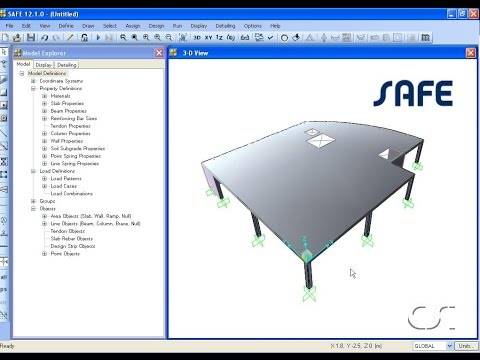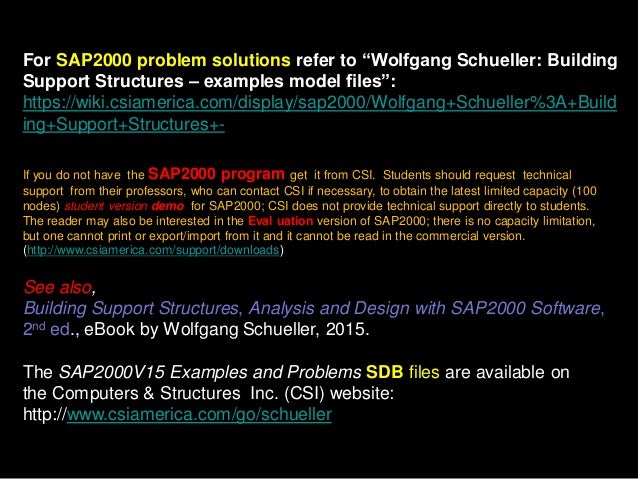Learn about the SAP2000 3D finite element based structural analysis and design program and how it can be used to perform a nonlinear static pushover analysis. The SAP name has been synonymous with state-of-the-art analytical methods since its introduction over 30 years ago. SAP2000 follows in the same tradition featuring a very sophisticated, intuitive and versatile user interface powered by an unmatched analysis engine and design tools for engineers working on transportation, industrial, public works, sports, and other facilities.
- SAP2000 follows in the same tradition featuring a very sophisticated, intuitive and versatile user interface powered by an unmatched analysis engine and design tools for engineers working on transportation, industrial, public works, sports, and other facilities.
- SAP2000 21.2.0 Enhancements – Analysis errors, warnings, and informational messages are now stored and shown after the analysis completes, as well as accessible via database tables – csiamerica.com SAP2000 21.2.0 Enhancements – Load combination results are now available on a step-by-step basis for linear load combinations containing one.
The SAP name has been synonymous with state-of-the-art analytical methods since its introduction over 30 years ago. SAP2000 follows in the same tradition featuring a very sophisticated, intuitive and versatile user interface powered by an unmatched analysis engine and design tools for engineers working on transportation, industrial, public works, sports, and other facilities.
From its 3D object based graphical modeling environment to the wide variety of analysis and design options completely integrated across one powerful user interface, SAP2000 has proven to be the most integrated, productive and practical general purpose structural program on the market today. This intuitive interface allows you to create structural models rapidly and intuitively without long learning curve delays. Now you can harness the power of SAP2000 for all of your analysis and design tasks, including small day-to-day problems. Complex Models can be generated and meshed with powerful built in templates. Integrated design code features can automatically generate wind, wave, bridge, and seismic loads with comprehensive automatic steel and concrete design code checks per US, Canadian and international design standards.
Advanced analytical techniques allow for step-by-step large deformation analysis, Eigen and Ritz analyses based on stiffness of nonlinear cases, catenary cable analysis, material nonlinear analysis with fiber hinges, multi-layered nonlinear shell element, buckling analysis, progressive collapse analysis, energy methods for drift control, velocity-dependent dampers, base isolators, support plasticity and nonlinear segmental construction analysis. Nonlinear analyses can be static and/or time history, with options for FNA nonlinear time history dynamic analysis and direct integration.
From a simple small 2D static frame analysis to a large complex 3D nonlinear dynamic analysis, SAP2000 is the easiest, most productive solution for your structural analysis and design needs.
* SAP2000 download link provides demo version of the software.
PERFORM-3D is a general tool for implementing displacement-based design, analysis and performance assesment for 3-d structures.
CSiBridge design allows for quick and easy design and retrofitting of steel and concrete bridges.
CSiPlant is an integrated engineering software product for analysis and design of piping systems and frame structures, .
Csi Sap2000 Download
ETABS is the solution, whether you are designing a simple 2D frame or performing a dynamic analysis of a complex high-rise that utilizes non-linear dampers for inter-story drift control.
CSiCOL is a comprehensive software package used for the analysis and design of columns.
SAFE is the ultimate tool for designing concrete floor and foundation systems. From framing layout all the way through to detail drawing production, SAFE integrates every aspect of the engineering design process in one easy and intuitive environment.
Submit a review using your Facebook ID
Skip to end of metadataGo to start of metadata
This space is devoted to SAP2000. Please visit the Technical Knowledge Base for documentation on topics common to all CSI Software.
SAP2000 is general-purpose civil-engineering software ideal for the analysis and design of any type of structural system. Basic and advanced systems, ranging from 2D to 3D, of simple geometry to complex, may be modeled, analyzed, designed, and optimized using a practical and intuitive object-based modeling environment that simplifies and streamlines the engineering process. The SAPFire ® Analysis Engine integral to SAP2000 drives a sophisticated finite-element analysis procedure. An additional suite of advanced analysis features are available to users engaging state-of-the-art practice with nonlinear and dynamic consideration. Created by engineers for effective engineering, SAP2000 is the ideal software tool for users of any experience level, designing any structural system.
Integrated modeling templates, code-based loading assignments, advanced analysis options, design-optimization procedures, and customizable output reports all coordinate across a powerful platform to make SAP2000 especially useful for practicing professionals.
SAP2000 is also an excellent medium for education. Open SAP2000 and follow the Watch & Learn video series to receive not only instruction on software use, but also insight into structural engineering philosophy and practice.

On this page:
Built-in modeling templates, a versatile and user-friendly interface, intuitive controls and features all combine to simplify and expedite a sophisticated object-based modeling process. A broad range of modeling options provide for methods and technologies at the forefront of structural engineering. Model domain may be component, system, or global-level in scope, while encompassing sub-grade components and soil-structure interaction. Grid line, snap, and replication tools are a few of the many practical features which make the modeling environment and process accessible to beginners, and sophisticated for advanced users.
Linear or curved members, cables and post-tensioned tendons, link elements to model springs, dampers, isolators, and the associated nonlinear and hysteretic behavior, framing, shell or multi-layered shell, solid elements with isoperimetric formulation and nonlinear response are all modeling options for object assembly in SAP2000. When preferred structural members are not provided in the extensive libraries of SAP2000, Section Designer is available for custom cross-section design. Users specify geometry and material composition before Section Designer automatically calculates member properties and generates biaxial-interaction and moment-curvature diagrams.
Nonlinear-fiber-hinge assignment is another advanced modeling technique available. SAP2000 implements code-based or empirical hinging behavior by modeling geometry and materials as discrete points within a cross-section, then correlating these discretized areas with their associated nonlinear behaviors. Limit-state and hysteretic considerations may also be implemented under nonlinear-static and dynamic analyses.
Csi America Sap2000
Once an object-based model is created, the SAPFire ® Analysis Engine automatically converts the assembly into a finite-element model by meshing the material domain with an efficient network of quadrilateral sub-elements. Joint-interpolation algorithms drive automatic edge-constraint technology to connect mesh mismatch. The Reshaper Tool is then available for mesh reshaping and refinement.
SAP2000 is the ideal tool for modeling structural systems of any complexity and any project type. Buildings, bridges, transportation infrastructure, such specialty structures as dams, sports facilities, and offshore systems are a few examples of the limitless design possibilities.
Powerful built-in templates also simplify and expedite the load-application process. Seismic, wind, vehicle, wave, and thermal forces may all be automatically generated and assigned according to a suite of code-based guidelines. Users are free to define and envelope an unlimited number of load cases and combinations.
Moving-load-generation features and a library of AASHTO vehicle applications provide for evaluation of transportation infrastructure systems. For marine systems, wave-load-generation features consider the static and dynamic response of wave, current, buoyancy, and wind while capturing inertial effects.
Enveloped load conditions may be coupled with certain advanced analysis and construction techniques (P-Delta effect, segmental construction, etc.) for additional insight into structural response.
A range of innovative analysis techniques are integrated into the capabilities of SAP2000. Users are free to supplement the standard yet sophisticated analysis process by implementing advanced features for nonlinear and dynamic consideration. This versatility makes SAP2000 a practical and productive tool for any analysis type ranging from simple static, linear-elastic to more complex dynamic, nonlinear-inelastic.
To begin, the SAPFire ® Analysis Engine drives analysis optimization with multiple 64-bit solvers. Options include Eigen analysis (with auto shifting for ill-conditioned relations) and Ritz analysis (for expedited convergence). P-delta effect captures geometric nonlinearity. Buckling analyses provide insight into structural stability through methods characterizing linear buckling (which considers multiple buckling modes under nonlinear-static or dynamic application), nonlinear buckling (which considers P-delta and large-deflection effects), snap-through buckling, and progressive collapse. Material nonlinearity capture inelastic and limit-state behavior, along with such time-dependent phenomena as creep and shrinkage behavior in reinforced-concrete systems. Plastic hinging may be specified in flexural members according to code-based standards or empirical data. Tension and compression-only springs may be assigned with limits and nonlinear attributes to simulate support plasticity.
Static and dynamic methods are available for earthquake simulation. Nonlinear-static-pushover analyses may consider modal, uniform, or user-defined lateral load patterns, plastic-hinging behavior of slender elements, inelastic response of shear walls, floor slabs, and steel plates, and then formulate demand-capacity, damping, and performance-point calculations with customizable summary reports.
Dynamic methods include response-spectrum (for likely maximum seismic response given pseudo-spectral acceleration vs. structural period curve), power-spectral-density and steady-state (for fatigue behavior with optional damping and complex-impedance properties), and time-history analyses. Time histories may follow modal or direct-integration methods, and they may be chained together and enveloped with such advanced analyses as P-delta and staged-construction procedures.
Staged-construction features are comprehensive. The construction sequence is scheduled with Gantt-chart options, enveloped with performance measures, and paired with analysis procedures. At each construction stage, evaluation may consider static or dynamic structural response, support reactions, geometric and material nonlinearity (including buckling, creep, and shrinkage), tendon and cable application with target-tensioning, etc. The Model Alive feature is available for small to medium-sized projects to analyze real or possible structural modifications.
Design is fully integrated with the analysis process, enveloping results before automatically sizing steel members and designing reinforced-concrete sections. Automatic steel, concrete, aluminum and cold-formed-framing design code checks ensure that structures meet criteria of American, Canadian, and a variety of international standards.
Output and display options are intuitive and practical. Finalized member design, deformed geometry per load combination or mode shape, moment, shear, and axial-force diagrams, section-cut response displays, and animation of time-dependent displacements outline a few of the graphics available upon conclusion of analysis. SAP2000 automatically generates reports for the presentation of images and data. Built-in and customizable templates are available to users for specialized formatting.
SAP2000 also provides a suite of interoperability features. Output reports may be transferred to Microsoft platforms in RTF file format or websites in HTML. SAP2000 models may import and export between CIS/2 STEP, SDNF, AutoCAD, Frameworks Plus, IGES, and Prosteel.
The SAP2000 Open Application Programming Interface (OAPI) allows developers to create custom programming applications linking related design platforms to SAP2000 function. Visual Basic and most standard languages are supported. Visit the OAPI page of the CSI Website to learn more about interoperability with SAP2000.
Several different levels of capability are offered for the SAP2000 product. Each subsequent level provides an additional set of features. Please refer to the Levels and Features page of the CSI Website for details.
Refer to the SAP2000 Tutorial page.
Refer to the SAP2000 Test Problems page.
Aviram, A., Mackie, K., Stojadinovic, B. (2008). Guidelines for Nonlinear Analysis of Bridge Structures in California. Berkeley, CA: Pacific Earthquake Engineering Research (PEER) Center.

